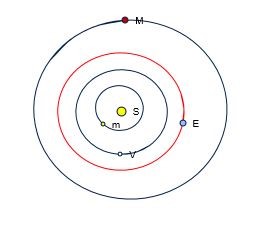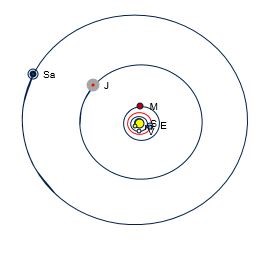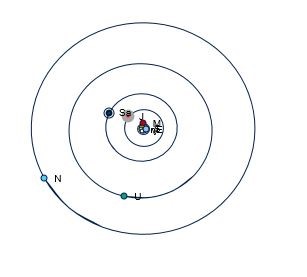|
|
Our Solar System, the Planets and When's Best to See Them (updated September 2025)
Our Solar System comprises 8 official planets and Pluto, which should be a proper planet but was demoted by the IAU in August 2006. Also in our Solar System are 556,000-ish comets, asteroids and other planets' moons. The planets are, of course, Mercury, Venus, Earth, Mars, Jupiter, Saturn, Uranus, Neptune, Pluto.
In common with our Moon, the planets provide essential viewing for amateur astronomers even from places of bad light pollution. Unlike most celestial objects, though, they do not appear in the same places in the sky at the same times of year. They move around. The word "planet" derives from the Greek Planetes, which means 'wanderer'. The following paragraphs and charts are guides as to the best times for the near future to observe them. They are charted, over the next one-two years, as follows: - Mercury - the charts show its altitude when the Sun is 3 degrees below the horizon, which is roughly when it should start to become visible to the naked eye. - Venus - altitude at the moment of sunset. Any later, she's too bright to view without being too dazzling to tease out any detail that might be available. - Mars, Jupiter et al - at approximate so-called "culmination" for the sites chosen, i.e. approximately midnight. "Culmination" is the point at which the object passes through the observer's South direction (for those in the North) and through the Northern meridian for observers in the South. Culmination represents the highest altitude it will reach. I've chosen two cities to serve as representatives of the Northern and Southern Hemispheres: London at 51.4 N and Sydney (or Capetown) at 34 S. Of course, if you observe from a different latitude these charts will move slightly "up" or "down", but the overall gist will be the same (unless you're close to the Equator - perhaps I should do some "Equator" charts too. For the future.). The planets will be perfectly observable outside the times indicated by the charts, which only show their elevations at near-enough midnight. Observing closer after sunset or into the early hours will effectively extend these charts "sideways". If you find the charts difficult or too small to see properly, just click on it and a full-res version should appear in a different tab. Mercury (updated September 2025) Mercury is the closest planet to the Sun, the distance of its orbit from the Sun varying between a third and a half of Earth’s, meaning its maximum apparent distance from the Sun is never more than about 23 degrees of arc across the sky (about the distance between your outstretched little-finger tip and thumb-tip at arm's length) and mostly much less. Because the immediate “movement” of the Sun during the day (and that of any other Celestial object including the stars and planets) is overwhelmingly due to the Earth’s rotation, not the object’s own movement, Mercury is basically following (or preceding) the Sun as it sets (or rises), and there is never much time between Sunset and "Mercuryset". Luckily, when fully illuminated, Mercury's brightness approaches that of the brightest star in the sky, at around magnitude -1. (Sirius, the actual brightest star, has magnitude -1.46; more negative means brighter). But Mercury, even at only 50% phase, i.e. "D"-shaped, has a magnitude of about 0, the same as Vega, which is the definitive 0-magnitude star. Consequently, the only realistic time to see Mercury is shortly after the Sun has set during twilight, and when it’s at “maximum elongation”, i.e. thrown out as far sideways in its orbit around the Sun from the viewpoint of an earthly observer. Furthermore, when it is at maximum elongation, the geometry of the situation means that it’ll be approximately 50% illuminated, and waning (getting less). The charts below show, for now and the near future, the altitude of Mercury each day when the Sun is 3 degrees below the horizon. They also show, in light blue on a scale from 0% to 100% the phase of Mercury, i.e. how much of a crescent or "full disc" it appears. Even seasoned astronomers get excited about seeing Mercury. Mercury 2025-2027
Mercury for an observer at 51.4 degrees N (e.g. London):
One year's pattern roughly repeats itself from a current year to the next, with the relevant events happening around a fortnight earlier each year.
Mercury for an observer at 34 degrees S (Sydney or Capetown):
Similarly to the Northern Hemisphere, the pattern more or less repeats every year. Venus (updated September 2025) Like Mercury, Venus’ orbit is inside that of Earth. Which means that she too follows the Sun down at Sunset when she’s that side of her orbit, and she precedes the Sun at Sunrise when on the other side of the Sun. Thus, being the first “star” to be visible as twilight beckons on account of her extreme brightness, Venus is often known as the Evening Star or the Morning Star, depending on which side of the Sun she is in her orbit. As the Evening Star, she'll be visible in the evening and will be the first "star" you'll see. As the Morning Star, she'll rise before dawn ahead of the Sun and will be the last to be extinguished to the naked eye before sunrise. Notwithstanding the above talk about "being extinguished", Venus is so extremely bright, magnitude -4 and therefore easily the brightest non-Sun object in the sky when she’s up, that she’s perfectly visible during the day. I actually prefer to view her in daytime because only then is she not dazzling in a telescope, and it's a nice party trick for the non-initiated. You likely won’t have noticed Venus during the day as she’s a tiny bright speck in an otherwise bright blue sky. To see her through binoculars, you do need to “hunt around” in the right area until you see the bright dot. Ironically, with a telescope it’s easier. Use an App to find the approximate altitude of Venus for the moment, and using a digital inclinometer, set the angle of the telescope to that angle. Then point the scope in roughly the right direction and scan from side to side. You’ll find her quickly. Observing Venus in darkness can be frustrating, because if there’s even a little turbulence in the atmosphere, called “bad seeing”, she will twinkle to the naked eye and the view through a telescope will produce enough sparkle and glare that you can’t really make out her shape. Venus 2025-2027 The charts of Venus’ altitude presented below are of Venus just after sunset, viewed from the Northern latitudes, London, and from Southern latitudes, e.g. Sydney or Capetown. Venus’ chart is plotted as her elevation as sunset. Actually she's best to observe before that because she’s so bright, but either way the chart tells the same story. For the Northern hemisphere, 2026 provides one “evening star” apparition for Venus, from January 2026 to September 2026, culminating during May at about 23 degrees up. Not bad, but it’s better for the Southern Hemisphere. For the SH, again starting to rise as an “evening star” from January 2026, Venus will rise to as much as 40 degrees up by August, before “crashing “ down very quickly as she swings around the Sun towards us. Mars (updated September 2025) The orbits of Mercury and Venus sit inside Earth’s orbit, meaning from an Earthly observer's point of view, they each appear relatively close to the Sun and seem to “follow the Sun around”, either ahead or behind. Consequently Mercury offers few opportunities for observing, and Venus is known as the Evening Star or Morning Star depending on which side of the Sun she is. Mars is different. His orbit, the outermost of the 4 “rocky” planets, sits outside Earth’s orbit. Meaning that Mars’ distance from and apparent size from an Earthly observer varies enormously, from as little as 4 arc-seconds diameter (1 arcsec=1/3600 of a degree), when Mars and Earth are at opposite sides of the Sun, to more than five times bigger at over 22 arc-seconds when they’re both at the same points on their orbits and closest together. See this diagram to see what I mean:
LEFT: Closest Together (Opposition) ..... RIGHT: Far Apart (both same scale)
Because Earth orbits inside Mars, we necessarily orbit faster (Kepler’s 3rd Law), in fact about twice as fast. So Earth and Mars get back to approximately the same positions relative to each other every two-ish years. A chart of Mars’ altitude (to an Earth-bound observer) will show a roughly two-year periodic pattern. Put another way, if Mars is at its closest – so-called "Opposition" - say now, one year later it will be at its furthest away and smallest. Mars 2025-2027 For both North and South of the Equator, Mars is largely absent from the night sky during 2026. Owing to its two-year cycle, Mars will spend much of its time the other side of the Sun, theoretically visible in the same sky as the Sun, i.e. during daytime. He will re-appear early 2027, culminating late Feb 2027 at 55 degrees up in the NH and 40 degrees up in the South. Jupiter (updated September 2025) Hop over the Asteroid Belt from Mars, and we get to the first of our two Gas Giants and our largest and most massive planet, Jupiter. Jupiter is very bright, second only to Venus amongst the planets. These remaining planets, Jupiter, Saturn, Uranus and Neptune, have approximately annual “visibility cycles” for observers on earth, because they are so far away causing them to move much more slowly across the starry tableau (Kepler’s 3rd Law) ~~~~~~ Jupiter 2025-2027 Jupiter orbits 5 times further from the Sun than earth, taking around 12 years to complete an orbit. Along with Saturn, it’s truly the most spectacular planet to observe through a telescope, and is a real test of a scope’s quality. On a night of good “seeing” and with a scope of high quality, its bands and details-within-bands are discernible, including the Great Red Spot. Its 4 largest Moons, the so-called “Galilean Moons”, Io, Europa, Ganymede and Callisto, can usually be seen as a line of bright dots near the planet, even through good-quality 8x or 10x hand-held binoculars. Because Jupiter takes 12 years to orbit the Sun, he will appear approximately 36 degrees further East at the same date each year. His apparent altitude also changes each year. The period 2024 to 2027 is very good for NH observers, in his "high period" reaching over 50-60 degrees at culmination. The opposite for SH observers, sadly, though he will still reach 30 40 degrees up in February 2026 and 40 degrees in February 2027. So Jupiter will culminate in December 2025 at over 60 degrees up for us in the NH, as high as it ever gets so a real treat, taking 3 months or so to “get up” and a further 3 months to recede; during all of which time he will be readily observable, i.e. from October 2025 to April 2026 The Southern Hemisphere shares the same apparition timing, but will generally be lower down, reaching only 30-40 degrees up.
Northern Hemisphere Jupiter
Saturn (updated September 2025) Next out from Jupiter orbits Saturn. Although Saturn’s orbit distance from the Sun is just under twice Jupiter’s, it takes almost 3 times as long to complete: nearly 30 years in fact (Kepler's Laws). Saturn is truly the Wow! or OMG! Planet, the reactions invariably elicited when people see Saturn through a telescope for the very first time. They never forget that first look, and most never lose the sense of wonder every time they see it. I certainly don’t. Saturn has (as of July 2024) 146 Moons of which several are visible in “backyard telescopes” such as ours. Some (most) are very small though. Saturn’s rings comprise almost entirely chunks of water ice, and the ring system is only about 20 metres (60 feet) thick! With a good telescope and good seeing, detail within Saturn’s rings can be seen, especially the so-called Cassini Division. Probably the same remarks about mesopic vision for Jupiter (see above) also apply to Saturn, i.e. that Saturn can also be usefully observed during twilight. Saturn 2025-2027 Saturn has by now well diverged from Jupiter, with whom it not-so-long-ago shared a portion of the sky: Saturn and Jupiter are now over 80 degrees apart, nearly a quarter of the sky. Indeed Saturn and Jupiter exhibited a “Great Conjunction” in December 2020, where they were nearly on top of one another! That was a sight to behold and won’t happen again until 2038. Like Jupiter, Saturn’s altitude for a NH observer is getting better year on year at the moment, just over 3.5 degrees higher at culmination per year, and improving for we NH-ers for at least a decade yet. Through a telescope, many of Saturn’s Moons are visible, dimmer than the Jupiter's "big four" and more scattered around the planet. However, the WOW factor of Saturn for the 2024/25 apparition may be reduced, as its rings are approaching edge-on. At perfectly edge-on, the ring system may well be nearly invisible, or they may present a bright straight line – we’ll have to see. Bragging rights (between Northern Hemisphere and Southern Hemisphere) as to who gets the better view of Saturn are the reverse from Jupiter. For the next couple of annual apparitions (as from Sep 2025) Saturn gets higher for the SH than for the NH. Saturn will reach 45 degrees altitude at the start of October 2026, versus just 40 degrees for those of us in the NH. For all observers, Saturn should be readily visible until November 2025, and then from August to December 2026. Also, at September 2025, Saturn’s rings are almost edge-on and only just visible as a sharp line through the planet, through a telescope. They will start to “open out” again from then though, allowing the Cassini Division to become evident again.
Northern Hemisphere Saturn
Uranus (updated September 2025) Uranus is the inner of the two “Ice Giants” (Jupiter and Saturn are the “Gas Giants”). Uranus is an oddity in some ways. The rest of the Solar System all mostly rotate and orbit in the same sense (Conservation of Angular Momentum of the gas cloud whence the Solar System was formed). If you were to look down from a long way North of the Solar System, you’d see that all the planets orbit in more or less the same plane around the Sun (called The Ecliptic) they all orbit the Sun in the same direction and they nearly all spin in that same direction. Which means their polar axes all point “up”, perpendicular-ish to the Ecliptic and their own orbits. Uranus is an exception. Uranus has been “tipped over”, so its rotational axis is on its side. It seems to “roll around” on its orbit. Which makes for very odd sunrises and sunsets for its inhabitants! (Venus is another oddity – it orbits like the rest, but spins the other way). Uranus orbits nearly twenty times further from the Sun than Earth, and takes 84 years to complete an orbit. It starts to allow the heavens give human lifespan some perspective. For observers, Uranus is just beyond naked eye for all but the very darkest skies and the sharpest eyes. Through a scope, however, it’s easily found, clearly blue-greenish and clearly a disc not a star. Two of its 28 so-far-discovered Moons, Titania and Oberon, are detectable in an amateur telescope, though the author has yet to do so. Uranus 2025-2027 Uranus is better for Northern observers than for Southerners, reaching nearly 60 degrees up each apparition, culminating November each year. The timing for Southerners is the same, but reaching only 35 degrees up.
Northern Hemisphere Uranus
Neptune (updated September 2025) Neptune is the outer of the two “Ice Giants”, orbiting 30 times as far as the earth and taking 165 years to complete an orbit around the Sun. To observe through a telescope, it’s a bit more of a challenge than Uranus, though under the right conditions it does appear greenish and as a disc, but you need high magnification to discern the latter. An experienced observer will certainly be able to find it. Of its 16 known Moons, Triton is detectable through an amateur scope on a night of good seeing. Neptune 2025-2027 Neptune is better from the South than from the North, reaching over 55 degrees altitude as opposed to 38 for Northerners, in each case culminating during September but observable for a good couple of months either side.
Northern Hemisphere Neptune
|
|
email: [email protected] | tel/WhatsApp: 089 613 0361
|


